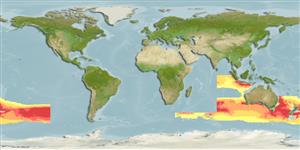>
Zeiformes (Dories) >
Oreosomatidae (Oreos) > Oreosomatinae
Etymology: Neocyttus: Greek, neos = new + Greek, kyttaros, kytos = a convex cavity; psilorhynchus: Named for the naked area on the snout..
More on authors: Yearsley & Last.
Environment: milieu / climate zone / depth range / distribution range
Écologie
marin bathypélagique; profondeur 750 - 1170 m (Ref. 30191). Deep-water
Indo-West Pacific: southwestern Australia, Tasmania and along Clatham Rise, east of New Zealand.
Taille / Poids / Âge
Maturity: Lm ? range ? - ? cm
Max length : 22.4 cm SL mâle / non sexé; (Ref. 30191)
Found on the continental slope, benthic (Ref. 75154).
Life cycle and mating behavior
Maturities | Reproduction | Spawnings | Egg(s) | Fecundities | Larves
Yearsley, G.K. and P.R. Last, 1998. Neocyttus psilorhynchus, a new oreosomatid (Pisces, Zeiformes) from southern Australia and New Zealand, with redescriptions of its congeners. N.Z. J. Mar. Freshwat. Res. 32(4):555-579. (Ref. 30191)
Statut dans la liste rouge de l'IUCN (Ref. 130435)
Menace pour l'homme
Harmless
Utilisations par l'homme
Outils
Articles particuliers
Télécharger en XML
Sources Internet
Estimates based on models
Preferred temperature (Ref.
123201): 2 - 2.9, mean 2.1 °C (based on 4 cells).
Phylogenetic diversity index (Ref.
82804): PD
50 = 0.5635 [Uniqueness, from 0.5 = low to 2.0 = high].
Bayesian length-weight: a=0.01622 (0.00733 - 0.03589), b=3.03 (2.83 - 3.23), in cm total length, based on LWR estimates for this (Sub)family-body shape (Ref.
93245).
Niveau trophique (Ref.
69278): 3.5 ±0.5 se; based on size and trophs of closest relatives
Résilience (Ref.
120179): Très faible, temps minimum de doublement de population supérieur à 14 ans (Preliminary K or Fecundity.).
Fishing Vulnerability (Ref.
59153): Low vulnerability (17 of 100).
